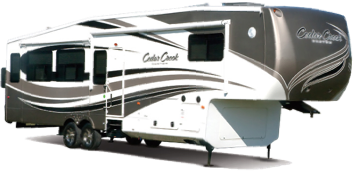How to Repair Your RV Toilet
RV Toilet Repair - RVing - Fun Times Guide
http://rv-roadtrips.thefuntimesguide.com/
Mon, 08 Sep 2008 00:00:00 -0700
To repair your RV toilet, follow these steps:
The first step is to turn off the water pressure — either by turning off the “City Water” valve or turning off the on switch for the on-board water pump.
Flush the toilet to bleed off any remaining water pressure and to empty all water out of the toilet bowl. The toilet will have to be removed in order to work on it, as repairs are made from the rear or bottom side.
Remove the 2 bolts (one on each side) that secure the toilet to the floor. You’ll then be able to lift the toilet away from the wall and access the water connection at the back side of the toilet. With the water line disconnected, you can then remove the toilet to a nearby work bench or table.
You might want to lay a cloth rag across the hole to help keep odors at bay, and to prevent anything from falling into the black water tank.
Unlike house toilets, RVs don’t use a wax ring to seal the toilet to the drain pipe. Instead, you will have a rubber ring that will act as the seal.
Depending on what portion of the toilet your repairs are concerned with, refer to the parts diagram that comes with the repair kit for dis-assembly instructions. Be sure when you order parts for the specific brand and model number of your RV toilet.
If you’re repairing the blade seals, before you reinstall the toilet in the RV, pour a quart of water into the toilet to make sure the new seals will hold water.
If you’re replacing the water valve on the back of the toilet, once you have reinstalled the water line, pressurize the water system to make sure the valve doesn’t leak. If it passes this test, then go ahead and bolt it back down to the floor.
It’s recommended that you install a new rubber seal between the toilet and the floor flange when you reinstall the toilet.
Toilet problems can really put the damper on a good RV outing. Fortunately repairing them isn’t really as bad as it sounds. The stinky part stays in the black water tank.
Read more ...
http://rv-roadtrips.thefuntimesguide.com/
Mon, 08 Sep 2008 00:00:00 -0700
To repair your RV toilet, follow these steps:
The first step is to turn off the water pressure — either by turning off the “City Water” valve or turning off the on switch for the on-board water pump.
Flush the toilet to bleed off any remaining water pressure and to empty all water out of the toilet bowl. The toilet will have to be removed in order to work on it, as repairs are made from the rear or bottom side.
Remove the 2 bolts (one on each side) that secure the toilet to the floor. You’ll then be able to lift the toilet away from the wall and access the water connection at the back side of the toilet. With the water line disconnected, you can then remove the toilet to a nearby work bench or table.
You might want to lay a cloth rag across the hole to help keep odors at bay, and to prevent anything from falling into the black water tank.
Unlike house toilets, RVs don’t use a wax ring to seal the toilet to the drain pipe. Instead, you will have a rubber ring that will act as the seal.
Depending on what portion of the toilet your repairs are concerned with, refer to the parts diagram that comes with the repair kit for dis-assembly instructions. Be sure when you order parts for the specific brand and model number of your RV toilet.
If you’re repairing the blade seals, before you reinstall the toilet in the RV, pour a quart of water into the toilet to make sure the new seals will hold water.
If you’re replacing the water valve on the back of the toilet, once you have reinstalled the water line, pressurize the water system to make sure the valve doesn’t leak. If it passes this test, then go ahead and bolt it back down to the floor.
It’s recommended that you install a new rubber seal between the toilet and the floor flange when you reinstall the toilet.
Toilet problems can really put the damper on a good RV outing. Fortunately repairing them isn’t really as bad as it sounds. The stinky part stays in the black water tank.
Read more ...



